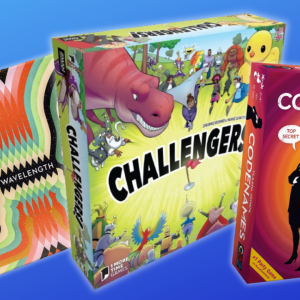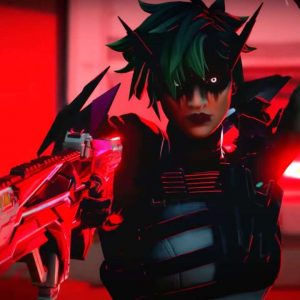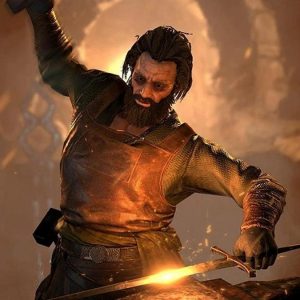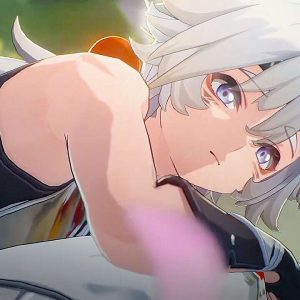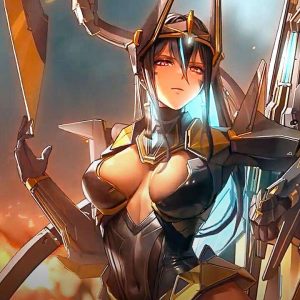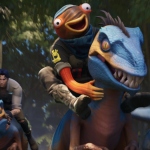In his own words, Stellar Blade Director Hyung-Tae Kim is a visualist, not a storyteller, meaning whatever Stellar Blade lacks in its story he’s tried to make up for in its gameplay. It’s a refreshingly transparent statement, and after playing through Stellar Blade, one I find mostly accurate. This is a gorgeous action game with excellent character and monster design and exciting combat that continues to evolve in fun and interesting ways across the 30-hour adventure. Its story, light RPG elements, and the actual substance of its characters, on the other hand, fall well short of the high mark set by its combat. Stellar Blade certainly isn’t pristine, and in some spots it’s positively dull, but it’s sharp in the areas that matter most.
Stellar Blade’s setting is a familiar one: The Earth is a post-apocalyptic wasteland, and humans have fled to a colony in space. You play as Eve – a member of the 7th Airborne Squad – who is sent to the surface to eliminate the threat of the Naytiba, horrific monsters that laid claim to Earth once the humans fled.
What follows is a predictable tale that sees Eve linking up with the last remnants of human civilization and collecting four hypercores guarded by four big bosses, each of which comes with new revelations that answer the questions of what happened to the Earth, why the humans fled to space, what created the Naytibas, and so on and so forth. None of the reveals were particularly surprising, and while the back half of the story is a bit more interesting once all the cards are laid out on the table, any emotional moments fell flat for me because of a near complete lack of character building in the front half.
And this is really the biggest issue with Stellar Blade’s story: its characters lack any kind of personality, charm, charisma, or anything that might have endeared me towards them in any way. After 30 hours I can barely tell you anything noteworthy about Eve outside of the fact that she’s fiercely dedicated to her mission; she’s very close with her fellow 7th airborne squadmate, Tachy; and she doesn’t like getting wet. We’re never given any sort of insight as to who she really is as a character, she’s got no sense of humor, and her interactions with her companions Adam and Lily are incredibly shallow. Those two don’t fare much better, either – despite the fact that they act like they share a strong bond, it never feels believable because you never really see it formed. Without any of that, it was hard to become invested in Eve, her mission, or Stellar Blade’s world in general.
Thankfully, the most important part of an action game is the action itself, and Stellar Blade checks pretty much all of the boxes when it comes to its combat. It’s smoothly animated, challenging, satisfying, has a healthy amount of enemy variety, and while there’s a lot of depth, it never became overwhelming in what it demanded of me.
You could say that Stellar Blade’s combat is derivative, but at the very least it’s derived from one of the best in Sekiro: Shadows Die Twice. Like Sekiro, it is very defense-driven – enemies are prone to launch into long, uninterruptible combos and the only way to properly deal with them is to precisely press the block button just before their attacks land to parry each attack, one after the other. Every parry you land takes away a point from the enemy’s balance, and once their balance is broken, you’re able to land a hugely damaging blow that will kill most standard enemies outright and deal massive damage to bosses.
Unparryable attacks are clearly telegraphed with flashes of color. A yellow flash means an attack is straight up unblockable and needs to be dodged; a blue flash signals an attack that you can Blink past by holding forward and dodging through the opponent to their backside; and then a purple flash is the sign of an attack that can be Repulsed, which forces you to hold back and press the dodge button at just the right time to deflect and expose the enemy’s weak point. Once again, all of this is very similar to Sekiro’s style of telegraphing unblockable moves that either must be jumped over, Mikiri Countered, or avoided at all costs, and it works just as well here.
Developer Shift Up smartly didn’t settle for just straight up copying Sekiro’s combat, either. It adds its own twists in the form of Beta Skills, which are a series of four special attacks that Eve can use for specific purposes – including a wide sweeping attack that hits multiple enemies, a triple stab attack that does massive single target damage, a shockwave type move that hits enemies at a distance, and a shield breaker that deals extra damage to an enemy’s armor. These attacks can be used by spending Beta Energy, which is gained by landing hits and parrying strikes, so you’re well incentivized to engage with the enemy as opposed to just running away and sneaking in a hit when you can.
Speaking of those enemies, one of the areas in which Stellar Blade particularly excels is in its enemy variety and design. There are more than 48 different types of Naytiba to fight against, and while some of them are only slight variations of each other with different weapons, at least those different weapons have their own combos and techniques that you still need to learn in order to properly deal with them. Boss fights are great too, with intense battles against huge and aggressive monsters that always had me on the edge of my seat.
Combat felt fresh all through the 30 hours it took me to beat it, partially because of the aforementioned enemy variety, but also because at just about every major chapter in the campaign, I would get a new tool or mechanic that changed up how I approached certain encounters. There’s a wrist mounted drone that could fire a bunch of different ammo types from a distance, along with new mechanics like Burst Skills that added yet another layer of resource management and became critical for tough fights.
Burst Skills are similar to Beta Skills, in that they are special attacks that require energy to use, but they are more powerful and typically result in an enemy being slumped on the ground. To balance that added strength, Burst Energy is much harder to build, requiring you to either perfectly dodge enemy attacks, successfully use a blink or repulse, or by spending a point of your Beta Energy to use a Beta Chain, which essentially exchanges the two resources. It was fun to make on the fly decisions about whether to spend two points of Beta Energy on a less powerful Beta Skill, or spend a single point to gain a point of Burst Energy and use a much stronger attack later.
It’s considerations like these that really make some of the tougher bosses in Stellar Blade sing. Not to mention the fact that the Burst Skills themselves just look cool as all hell. The cherry on top of all of this excellent action is the exceptional soundtrack, which features everything from blood pumping bangers during boss battles, to beautiful, ear-tingling melodies while exploring its desolate world.
When you’re not hacking away at Stellar Blade’s horrific looking Naytiba monstrosities, you’ll be doing some light RPG activities like exploring Xion (mankind’s last bastion of civilization), restocking at shops, changing your hair, picking up quick and light requests from a bulletin board, or taking on meatier sidequests from NPCs. True to everything else in Stellar Blade, none of these tasks were particularly interesting from a storytelling perspective, save for one involving a man and his love for a broken down singing android. They do occasionally culminate in a big “round two” fight against a stronger version of a boss that I had previously fought, but outside of those few moments, I quickly found myself tired of the sidequest grind.
First off, many of these sidequests have you returning to old levels in order to reach a specific spot to either pick up some sort of note or item to deliver back to the quest giver. While this is mostly fine in the more open ended zones where there’s a map and numerous fast travel points to make travel much less of a chore, it is an absolute pain when it comes to the linear levels where you have nothing to guide you but a blip on your compass. Most of the time virtually nothing has changed in these levels either, so it’s literally just retracing your steps through the same level, minus any of the surprises you might have encountered on your first time through, all to collect a single item that you weren’t able to pick up before.
What makes this worse is that very rarely did I ever feel like the effort was worth the trip. Most of the time the rewards are just Gold and EXP. EXP is great, as level ups give you skill points to explore more of Stellar Blade’s well developed skill trees. But later on, which was when the sidequest fatigue started to settle in, skill points were less exciting because the remaining upgrades were either skills that I had passed on because I didn’t really feel like I needed them, felt like very incremental stat increases on moves that I didn’t use very often, or were extremely situational upgrades.
Then there’s Gold, which for the most part is a useless currency in the latter half of the campaign. It’s used pretty much exclusively for refilling consumables or getting more crafting components, which I practically never had to do because you find so many of all of those things just by opening treasure chests and breaking boxes.
Thankfully, exploration fares better. The two open zones of Stellar Blade aren’t enormous, but they are densely packed with hidden collectibles and fun enemy encounters that always made me want to thoroughly explore as much as I could before making a break for the objective marker. There are collectible cans that can be returned to your base for a variety of rewards, core parts that increase your max health and energy, robot loot pinatas that contain all sorts of goodies, exoskeletons that greatly alter your stats and can affect your approach to combat, and of course, 30-or-so outfits that you can use to change Eve’s appearance. There is an impressive variety among those costumes, so for every skimpy swimsuit or super tiny miniskirt, there’s also a classy dress or stylish outfit that makes Eve look like, as my wife put it, “An Insta Baddie”. I always looked forward to finding a new skin, and truthfully, it’s very satisfying to have another big action game outside of Insomniac’s Spider-Man series that features really high quality unlockable cosmetics that you don’t have to purchase with real money microtransactions.
One other feather in Stellar Blade’s cap is that it mixes up its gameplay fairly well. It’s not all just hacking and slashing. Occasionally you’ll have to go deep underground into a creepy lab where your scanner and sword don’t work, turning it into a genuinely spooky survival horror style game. There are also some cool Uncharted like action sequences as well as a good mix of linear and non-linear level design. Not all of these breaks from combat hit, and the platforming-heavy sections are particularly annoying whenever they come up, but they nonetheless do a good job of relieving the monotony that would come from just going from fight-to-fight with nothing in between.
After beating Stellar Blade, it’s also worth mentioning that there’s no New Game+ at launch. It will be coming down the line as free DLC, but right out of the gate, there’s not much waiting for you at the end beyond a hard mode that doesn’t seem to change much outside of enemies hitting you harder. This is especially frustrating because once you beat the game, your save file with all of your unlockables, costumes, and other collectibles is basically stuck at the final boss fight. You can’t take those costumes over with you to a new game, forcing you to do an entirely fresh playthrough, outside of one new costume that you get for beating the game, and you can’t even skip cutscenes on your subsequent playthroughs.
[editor’s note]: Right after this review was published, a patch dropped that added New Game+. It doesn’t change the score or verdict of the review, but it is a very welcome addition. They said they were adding it soon, and I guess they really meant it!

